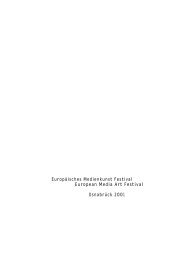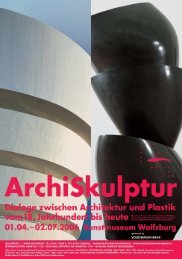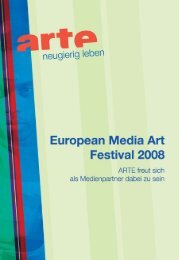EUROPEAN MEDIA ART FESTIVAL OSNABRUECK 2011 - Emaf
EUROPEAN MEDIA ART FESTIVAL OSNABRUECK 2011 - Emaf
EUROPEAN MEDIA ART FESTIVAL OSNABRUECK 2011 - Emaf
You also want an ePaper? Increase the reach of your titles
YUMPU automatically turns print PDFs into web optimized ePapers that Google loves.
RETROSPECTIVE<br />
FILMS BY STANDISH LAWDER<br />
CATFILM FOR URSULA &<br />
CATFILM FOR KATY AND CYNNIE<br />
Standish Lawder<br />
In den frühen 70er-Jahren verantaltete eine New Yorker Katzenliebhaberin<br />
und Filmemacherin, Pola Chapelle, ein ›Festival mit Katzenfilmen‹: es<br />
wurde in einem großen Saal im Zentrum von New York City dem Publikum<br />
präsentiert, das aus mehr als tausend Katzenliebhabern bestand. Zu<br />
dem Zeitpunkt lebte ich mit meiner Frau Ursula und unseren Töchtern<br />
Katy und Cynnie und vielen Katzen, viel zu vielen Katzen, zusammen. Ich<br />
liebte meine Familie, aber nicht die Katzen.<br />
Eine unserer Katzen aber wedelte endlos mit ihrem Schwanz, so lange<br />
wie man ihr den Nacken kraulte und mit der richtigen Musik als Filmmusik<br />
sah es wirklich so aus, als würde sie die Musiker dirigieren. Daraus<br />
entstand Catfilm for Ursula. Das Publikum liebte diesen Film, and ich bekam<br />
dafür ein Paket Katzenfutter ›verliehen‹. Zu meiner Enttäuschung<br />
war das Publikum jedoch nur daran interessiert Katzen zu sehen; offensichtlich<br />
machten sie sich nichts aus der wunderbaren Filmkunst. Als<br />
dann das zweite ›Festival mit Katzenfilmen‹ angekündigt wurde, kam ich<br />
auf die Idee mit ihrer Leidenschaft zu spielen. Zunächst sperrte ich drei<br />
Katzen für zwei Tage in ein Badezimmer, ohne Futter, um sicherzugehen,<br />
dass sie danach extrem hungrig waren. Anschließend nahm ich eine<br />
große Glasscheibe, stellte meine Kamera darunter, bedeckte das Glas mit<br />
einer Mischung aus Milch und Mehl und platzierte die hungrigen Katzen<br />
oben auf die Glasscheibe. So entstand Catfilm for Katy and Cynnie. Im ersten<br />
Moment als das Publikum auf die weiße Leinwand schaute hassten<br />
sie ihn: Wo waren die Katzen? ... bis schließlich, zu ihrem unendlichen<br />
Vergnügen, die Katzen ins Bild kamen, indem sie die weiße Schicht<br />
wegleckten und sich so immer mehr zeigten.<br />
In the early 70's, a New York cat-lover and film-maker named Pola<br />
Chapelle produced a ›Cat Film Festival:‹ which was shown in a large<br />
downtown NYC auditorium to an audience of more than a thousand catlovers.<br />
At the time, I lived with my wife Ursula and our daughters Katy and<br />
Cynnie, together with many, too many cats. I loved my family but not the<br />
cats.<br />
But one of our cats would wag her tail endlessly as long as her neck was<br />
stroked and, with the right music on the film's sound track, she really<br />
looked like she was conducting the musicians. This idea became Catfilm<br />
for Ursula. The audience loved it, and I was awarded a carton of cat food<br />
for the film. But to my disappointment, this audience was only interested<br />
in just seeing cats; obviously they cared not at all about the wonderful art<br />
of film. So when the second ›cat film festival‹ was announced, I decided<br />
to play with their obsession. First, I put three cats in a bathroom without<br />
food for two days to make sure they were super-hungry. Then I took a<br />
large glass panel and placed my camera underneath it, then covered the<br />
glass with a mixture of milk and flour and placed the hungry cats on top<br />
of the glass. This became Catfilm for Katy and Cynnie. At first, while looking<br />
at a blank screen, the audience hated it: Where are the cats? ...until<br />
finally, to their hysterical delight, the cats appeared by licking away to reveal<br />
themselves.<br />
�Catfilm for Ursula<br />
1971, 16mm, color, optical sound, 4:00<br />
�Catfilm for Katy and Cynnie<br />
1973, 16mm, color, silent, 4:00<br />
120<br />
RAINDANCE<br />
Standish Lawder<br />
RAINDANCE spielt sich durch die programmatische<br />
Simulation des zentralen<br />
Nervensystems direkt im Kopf ab.<br />
Die Netzhaut des Auges wird einzelnen<br />
Bildern des Films in einem Rhythmus,<br />
einer Sequenz und einer Intensität<br />
ausgesetzt, die den Frequenzen der Alphawellen<br />
des Hirns entsprechen. RA-<br />
INDANCE wird zu einer Erfahrung meditativer<br />
Freiheit über die Grenzen des<br />
visuellen Verständnisses hinaus. Die<br />
Sicht ist nach innen gerichtet. Der Film<br />
lenkt unsere mentalen Prozesse, steuert<br />
wie wir denken und was wir sehen.<br />
Bilder verschwimmen mit ihrem Hintergrund,<br />
Farben enstehen aus dem,<br />
was überanspruchte Nervenenden<br />
über das Auge abgeben, Formen tanzen<br />
durch kurzgeschlossene Synapsen des<br />
Gehirns. RAINDANCE besteht ausschließlich<br />
aus einem Stück gefundenem<br />
Filmmaterial eines alten Zeichentrickfilms,<br />
das einen dichten Regenvorhang<br />
zeigt. Der Zeichentrickfilm hatte den<br />
Titel ›The History of Cinema.‹<br />
RAINDANCE plays directly on the mind<br />
through programmatic stimulation of<br />
the central nervous system. Individual<br />
frames of the film are imprinted on the<br />
retina of the eye in a rhythm, sequence,<br />
and intensity that corresponds to Alpha-Wave<br />
frequencies of the brain.<br />
RAINDANCE becomes an experience of<br />
meditative liberation beyond the<br />
threshold of visual comprehension. Vision<br />
turns inward. The film directs our<br />
mental processes, controlling how we<br />
think as well as what we see. Images<br />
fuse with their afterimages, colors<br />
arise from retinal release of exhausted<br />
nerve endings, forms dance across<br />
short-circuited synapses of the mind.<br />
RAINDANCE was made entirely from a<br />
scrap of found footage taken from an<br />
old animated cartoon representing a<br />
sheet of falling rain. The cartoon was<br />
called, ›The History of Cinema.‹<br />
�1972, 16mm, color, optical sound,<br />
17:00<br />
�music by Robert Withers












